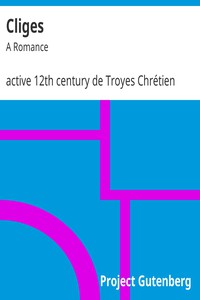Four Arthurian Romances by active 12th century de Troyes Chrétien (red white royal blue .TXT) 📖

Book online «Four Arthurian Romances by active 12th century de Troyes Chrétien (red white royal blue .TXT) 📖». Author active 12th century de Troyes Chrétien
of the 12th Century A.D., by the court poet Chretien DeTroyes.
SELECTED BIBLIOGRAPHY:
INTRODUCTION
EREC ET ENIDE
CLIGES
YVAIN
LANCELOT
SELECTED BIBLIOGRAPHY: ORIGINAL TEXT—
Carroll, Carleton W. (Ed.): "Chretien DeTroyes: Erec and Enide" (Garland Library of Medieval Literature, New York & London, 1987). Edited with a translation (see Penguin Classics edition below).
Kibler, William W. (Ed.): "Chretien DeTroyes: The Knight with the Lion, or Yvain (Garland Library of Medieval Literature 48A, New York & London, 1985). Original text with English translation (See Penguin Classics edition below).
Kibler, William W. (Ed.): "Chretien DeTroyes: Lancelot, or The Knight of the Cart (Garland Library of Medieval Literature 1A, New York & London, 1981). Original text with English translation (See Penguin Classics edition below).
Micha, Alexandre (Ed.): "Les Romans de Chretien de Troyes, Vol. II: Cliges" (Champion, Paris, 1957).
OTHER TRANSLATIONS—
Cline, Ruth Harwood (Trans.): "Chretien DeTroyes: Yvain, or the Knight with the Lion" (University of Georgia Press, Athens GA, 1975).
Kibler, William W. & Carleton W. Carroll (Trans.): "Chretien DeTroyes: Arthurian Romances" (Penguin Classics, London, 1991). Contains translations of "Erec et Enide" (by Carroll), "Cliges", "Yvain", "Lancelot", and DeTroyes' incomplete "Perceval" (by Kibler). Highly recommended.
Owen, D.D.R (Trans.): "Chretien DeTroyes: Arthurian Romances" (Everyman Library, London, 1987). Contains translations of "Erec et Enide", "Cliges", "Yvain", "Lancelot", and DeTroyes' incomplete "Perceval". NOTE: This edition replaced W.W. Comfort's in the Everyman Library catalogue. Highly recommended.
RECOMMENDED READING—
Anonymous: "Lancelot of the Lake" (Trans: Corin Corely; Oxford University Press, Oxford, 1989). English translation of one of the earliest prose romances concerning Lancelot.
Anonymous: "The Mabinogion" (Ed: Jeffrey Gantz; Penguin Classics, London, 1976). Contains a translation of "Geraint and Enid", an earlier Welsh version of "Erec et Enide".
Anonymous: "Yvain and Gawain", "Sir Percyvell of Gales", and "The Anturs of Arther" (Ed: Maldwyn Mills; Everyman, London, 1992). NOTE: Texts are in Middle-English; "Yvain and Gawain" is a Middle-English work based almost exclusively on Chretien DeTroyes' "Yvain".
Malory, Sir Thomas: "Le Morte D'Arthur" (Ed: Janet Cowen; Penguin Classics, London, 1969).
INTRODUCTION
Chretien De Troyes has had the peculiar fortune of becoming the best known of the old French poets to students of mediaeval literature, and of remaining practically unknown to any one else. The acquaintance of students with the work of Chretien has been made possible in academic circles by the admirable critical editions of his romances undertaken and carried to completion during the past thirty years by Professor Wendelin Foerster of Bonn. At the same time the want of public familiarity with Chretien's work is due to the almost complete lack of translations of his romances into the modern tongues. The man who, so far as we know, first recounted the romantic adventures of Arthur's knights, Gawain. Yvain, Erec, Lancelot, and Perceval, has been forgotten; whereas posterity has been kinder to his debtors, Wolfram yon Eschenbach, Malory, Lord Tennyson, and Richard Wagner. The present volume has grown out of the desire to place these romances of adventure before the reader of English in a prose version based directly upon the oldest form in which they exist.
Such extravagant claims for Chretien's art have been made in some quarters that one feels disinclined to give them even an echo here. The modem reader may form his own estimate of the poet's art, and that estimate will probably not be high. Monotony, lack of proportion, vain repetitions, insufficient motivation, wearisome subtleties, and threatened, if not actual, indelicacy are among the most salient defects which will arrest, and mayhap confound, the reader unfamiliar with mediaeval literary craft. No greater service can be performed by an editor in such a case than to prepare the reader to overlook these common faults, and to set before him the literary significance of this twelfth-century poet.
Chretien de Troyes wrote in Champagne during the third quarter of the twelfth century. Of his life we know neither the beginning nor the end, but we know that between 1160 and 1172 he lived, perhaps as herald-at-arms (according to Gaston Paris, based on "Lancelot" 5591-94) at Troyes, where was the court of his patroness, the Countess Marie de Champagne. She was the daughter of Louis VII, and of that famous Eleanor of Aquitaine, as she is called in English histories, who, coming from the South of France in 1137, first to Paris and later to England, may have had some share in the introduction of those ideals of courtesy and woman service which were soon to become the cult of European society. The Countess Marie, possessing her royal mother's tastes and gifts, made of her court a social experiment station, where these Provencal ideals of a perfect society were planted afresh in congenial soil. It appears from contemporary testimony that the authority of this celebrated feudal dame was weighty, and widely felt. The old city of Troyes, where she held her court, must be set down large in any map of literary history. For it was there that Chretien was led to write four romances which together form the most complete expression we





Comments (0)